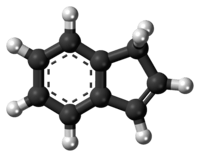Indene
 | |
 | |
| Names | |
|---|---|
| Preferred IUPAC name
1H-Indene | |
| Systematic IUPAC name
Bicyclo[4.3.0]nona-1,3,5,7-tetraene | |
| Other names
Benzocyclopentadiene Indonaphthene | |
| Identifiers | |
| 95-13-6 | |
| 3D model (Jmol) | Interactive image |
| 635873 | |
| ChEBI | CHEBI:41921 |
| ChEMBL | ChEMBL192812 |
| ChemSpider | 6949 |
| DrugBank | DB02815 |
| ECHA InfoCard | 100.002.176 |
| 27265 | |
| KEGG | C11565 |
| PubChem | 7219 |
| |
| |
| Properties | |
| C9H8 | |
| Molar mass | 116.16 |
| Appearance | Colorless liquid[1] |
| Density | 0.997 g/mL |
| Melting point | −1.8 °C (28.8 °F; 271.3 K) |
| Boiling point | 181.6 °C (358.9 °F; 454.8 K) |
| Insoluble | |
| Acidity (pKa) | 20.1 (in DMSO)[2] |
| Hazards | |
| Main hazards | Flammable |
| Flash point | 78.3 °C (172.9 °F; 351.4 K) |
| US health exposure limits (NIOSH): | |
| PEL (Permissible) |
none[1] |
| REL (Recommended) |
TWA 10 ppm (45 mg/m3)[1] |
| IDLH (Immediate danger) |
N.D.[1] |
| Except where otherwise noted, data are given for materials in their standard state (at 25 °C [77 °F], 100 kPa). | |
| | |
| Infobox references | |
Indene is a flammable polycyclic hydrocarbon with chemical formula C9H8. It is composed of a benzene ring fused with a cyclopentene ring. This aromatic liquid is colorless although samples often are pale yellow. The principal industrial use of indene is in the production of indene/coumarone thermoplastic resins.
Isolation
Indene occurs naturally in coal-tar fractions boiling around 175–185 °C. It can be obtained by heating this fraction with sodium to precipitate solid "sodio-indene." This step exploits indene's weak acidity evidenced by its deprotonation by sodium to give the indenyl derivative. The sodio-indene is converted back to indene by steam distillation.[3]
Reactivity
Indene readily polymerises. Oxidation of indene with acid dichromate yields homophthalic acid (o-carboxylphenylacetic acid). It condenses with ethyl oxalate in the presence of sodium ethoxide to form indene-oxalic ester, and with aldehydes or ketones in the presence of alkali to form benzofulvenes. The latter are highly coloured. An indene is also a precursor to the indenyl anion, a ligand in organometallic chemistry with some notability due to the indenyl effect.
See also
References
- 1 2 3 4 "NIOSH Pocket Guide to Chemical Hazards #0340". National Institute for Occupational Safety and Health (NIOSH).
- ↑ Bordwell FG (1988). "Equilibrium acidities in dimethyl sulfoxide solution". Accounts of Chemical Research. 21 (12): 456–463. doi:10.1021/ar00156a004. Bordwell pKa Table in DMSO
- ↑ Gerd Collin, Rolf Mildenberg, Mechthild Zander, Hartmut Höke, William McKillip, Werner Freitag, Wolfgang Imöhl “Resins, Synthetic” Ullmann's Encyclopedia of Industrial Chemistry Wiley-VCH, Weinheim, 2000.
External links
- W. v. Miller, Rohde (1890). "Zur Synthese von Indenderivaten". Berichte der deutschen chemischen Gesellschaft. 23 (2): 1881–1886. doi:10.1002/cber.18900230227.
- W. v. Miller, Rohde (1890). "Zur Synthese von Indenderivaten". Berichte der deutschen chemischen Gesellschaft. 23 (2): 1887–1902. doi:10.1002/cber.18900230228.
- Finar, I. L. (1985). Organic Chemistry. Longman Scientific & Technical. ISBN 0-582-44257-5.